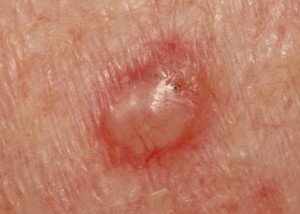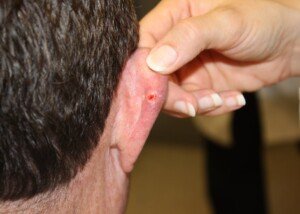If you have a basal cell carcinoma on the back of your ear, here’s what to expect.
This area requires laser sharp expertise for treatment.
The most common cancer in the world is basal cell carcinoma.
Though it’s essentially a nonfatal disease in developed countries, it can still cause massive tissue destruction if left untreated.
It’s caused by excessive exposure to sunlight, and even dark skinned people can be diagnosed with this cancer.
Basal cell carcinoma, then, can arise in any area of the body that gets too much sun exposure.
This includes the back of the ear or behind the ear.
What to Expect with a Diagnosis of BCC Behind the Ear
“Regarding basal cell carcinoma on the back of the ear, there are a few key factors to consider,” says Alpana Mohta, MD, DNB, a dual board certified dermatologist who specializes in clinical and aesthetic dermatology.
“Firstly, lesions in the H-area, which includes the ears, central face, eyelids, lips, nose and chin, are regarded as high risk for recurrence.
“Given the complexity of the auricular (ear) and periauricular (around the ear) regions, it is crucial to have surgical expertise in these areas to balance optimal cosmetic outcomes with obtaining negative margins.”
Negative margins are the goal of the skin cancer surgeon: Removing all layers of malignant cells plus additional layers of benign skin while preserving an optimal appearance once the area has completely healed from the surgery.
“As a result, surgical excision is typically recommended with 5- to 6-mm margins or Mohs micrographic surgery (MMS) to ensure complete removal of the cancerous cells,” continues Dr. Mohta.
“After the surgical excision, the wound is often closed with primary closure or reconstructed using local tissue flaps, skin grafts — or allowed to heal by secondary intention [left open to heal naturally].
“It is important to achieve negative margins, meaning all cancer cells have been removed, as recurrent BCC lesions tend to be more aggressive.
“Additionally, due to repeated and chronic sun exposure, there is a risk of recurrence of BCC over this site.”
Not too many people who apply sunscreen think to rub it in behind the ears, right up against the back of the ears, on the lobes and the folds inside the ear.
These areas get hit by the sun as much as any other area of the face unless enough hair or a wide-brimmed hat shields that area.
“In some cases, referral to otolaryngologists (ear, nose and throat specialists) may be necessary based on the specific characteristics of the lesion or the need for more extensive surgical techniques.”
Future Surveillance for a BCC Recurrence
Once you develop a BCC, you’ll always be at increased risk for another BCC, no matter how much sunblock you slather on.
Often, the sun damage that led to your first basal cell carcinoma occurred in childhood.
A future BCC, even if it’s several years later, may be the result of all the sunning you got as a teenager, even as a younger child.
But a recurrence can also be the result of too much sun in later adulthood.
If for instance you’re 50 and have had two basal cell carcinomas, it’s crucial to vigilantly protect your skin so that when you’re 70, you don’t develop yet another BCC (or squamous cell carcinoma, for that matter) from excess sunlight between 50 and 70.
“Patients with a high risk of recurrent basal cell carcinomas, like those suffering from genetic diseases including Gorlin syndrome, Bazex-Dupré-Christol syndrome, xeroderma pigmentosa and Rombo syndrome, require regular surveillance,” says Dr. Mohta.
“Regarding future surveillance, it’s essential to understand that having a BCC at the back of the ear increases your risk of developing additional skin cancers.
“Additionally, patients with fair skin, blue or light colored eyes, blond or red hair, those who use tanning beds or outdoor tanning very frequently, and have suffered recurrent sunburns, require regular surveillance.
“Although there are no set guidelines for surveillance, a yearly complete skin examination for melanoma and non-melanoma skin cancers is advised for the general population.
“During these examinations, your dermatologist will carefully inspect your entire skin surface, including the back of your ear, for any suspicious lesions or signs of recurrence.”
Even if you have thick hair that regularly covers your ears, this area should be examined.
“They may also use dermascopy, a specialized technique using a magnifying device, to aid in examining and evaluating skin lesions.
“In addition to that, patients should also perform self-examinations every month.
“Familiarize yourself with the appearance of your skin, including the back of your ear, and promptly report any new or changing lesions to your dermatologist.”
Tips for Examining Behind, Along the Lobe and Inside Your Ears for Skin Cancer
• Use the same room, same lighting, every single time.
• Make sure your ears are cleaned out.
• You’ll need a regular mirror on the wall plus a hand mirror.
• It’ll be awkward at first, but eventually you’ll get pretty good at knowing just how to position the hand mirror to get a great view of the back of your ear, plus all along the lobe including its top, plus inside the ear.
• You’ll learn how to use your free hand to gently tug at your ear to make areas more viewable.
• You can use the light on your phone to shine inside your ear to look for any new nodules, patches or spots.
 Dr. Alpana Mohta is a dual board certified dermatologist and owner of dralpana.com. Her areas of interest include clinical dermatology, dermatopathology and dermatosurgery. She has over 85 research publications in numerous journals. Apart from her regular medical practice, she is also a medical writer, reviewer and advisor for many companies.
Dr. Alpana Mohta is a dual board certified dermatologist and owner of dralpana.com. Her areas of interest include clinical dermatology, dermatopathology and dermatosurgery. She has over 85 research publications in numerous journals. Apart from her regular medical practice, she is also a medical writer, reviewer and advisor for many companies.
 Lorra Garrick has been covering medical, fitness and cybersecurity topics for many years, having written thousands of articles for print magazines and websites, including as a ghostwriter. She’s also a former ACE-certified personal trainer.
Lorra Garrick has been covering medical, fitness and cybersecurity topics for many years, having written thousands of articles for print magazines and websites, including as a ghostwriter. She’s also a former ACE-certified personal trainer.
.










































